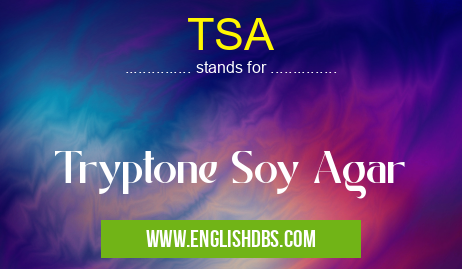What does TSA mean in UNCLASSIFIED
Tryptone Soy Agar, often abbreviated as TSA, is a type of laboratory agar that serves as a medium in which to grow and culture different microorganisms. It provides an environment for nutrients needed by bacteria to grow, enabling researchers and scientists to observe the growth of different types of bacteria. It is widely used in microbiology labs for the purpose of qualitatively distinguishing different types of bacteria based on their morphology.

TSA meaning in Unclassified in Miscellaneous
TSA mostly used in an acronym Unclassified in Category Miscellaneous that means Tryptone Soy Agar
Shorthand: TSA,
Full Form: Tryptone Soy Agar
For more information of "Tryptone Soy Agar", see the section below.
What Is TSA Made Of?
TSA consists of two components: tryptone and soybean-casein digest medium. Tryptone is a source of nitrogen and carbon derived from protein hydrolysates formed from enzymatic digestion of meat proteins; this provides essential amino acids for bacterial growth. The soybean-casein digest medium is made up of animal milk proteins that serve as nitrogenous sources; these provide vital vitamins and minerals required in order for the bacteria to thrive in the agar. In addition, there are also small amounts of salts, sugars, carbohydrates, fatty acids, and other substances present in TSA that play vital roles in providing nutrients necessary for proper bacterial growth and development.
Benefits Of Using TSA
Using TSA has many advantages compared to using other media when it comes to culturing different kinds of microorganisms. One benefit is that it allows researchers to observe the growth patterns and characteristics of various microorganisms more efficiently since TSA does not require additional additives or supplements such as pH indicators or antibiotics. Furthermore, because it contains proteinaceous material with essential amino acids and other nutrients required for cell metabolism, it can be easily customized depending on the requirements at hand. This makes working with this type of medium much more efficient than having to purchase numerous specially prepared media every time one needs a specific nutrient profile or pH level for an experiment.
Essential Questions and Answers on Tryptone Soy Agar in "MISCELLANEOUS»UNFILED"
What is Tryptone Soy Agar?
Tryptone Soy Agar (TSA) is a nutrient culture medium used in the laboratory to grow and maintain non-fastidious microorganisms. It is made from a combination of tryptone, an enzymatic digest of casein, and soytone, an enzymatic digest of soybean meal, with added sodium chloride brine. TSA often also contains agar (a seaweed extract) or other carbohydrates for organism growth.
How do you prepare Tryptone Soy Agar?
To prepare TSA in the lab, combine the ingredients in distilled water and heat until boiling. Stir the mixture until all solids have dissolved, then filter sterilize through a 0.2 micron filter and pour into Petri plates when cooled to ~50°C. The amount of agar used can be adjusted depending on desired plate hardness; however, too much agar can inhibit organism growth and too little will make the plates overly soft.
What organisms are grown on Tryptone Soy Agar?
TSA is primarily used for the cultivation of non-fastidious bacteria, such as Enterobacteriaceae including Escherichia coli, Klebsiella pneumoniae, Shigella spp., Serratia marcescens, Proteus spp., Streptococcus spp., Staphylococcus spp., Neisseria gonorrhoeae and Listeria monocytogenes. Some fungi may also grow on TSA although they generally prefer richer media such as Sabouraud Dextrose Agar or Potato Dextrose Agar.
Is there a TTC (2,3,-Dibromothiophene-1-ol)-free version of Tryptone Soy Agar?
Yes!TTC-free versions of TSA are available commercially that are free from 2,3,-Dibromothiophene-1-ol which can interfere with microbial growth and metabolism when present at levels greater than 50 ppm (parts per million). These versions use alternative dyes such as tetrazolium chloride instead of TTC for detection of microbial growth.
Why is Phenol Red added to Tryptone Soy Agar?
Phenol Red is often added to TSA as an indicator dye for determining pH changes due to microbial metabolism during incubation. Depending on the pH level within the medium due to metabolic activity by microorganisms present in it will cause subtle colour changes in Phenol Red ranging from yellow at low acidic levels to red at higher alkaline levels.
What type of packaging should I use when ordering ready-to-use plates or components containing Tryptone Soy Agar?
Any ordered goods containing TSA should be packaged securely using airtight ethylene vinyl acetate bags or rigid plastic boxes with tight fitting lids for extra protection during transportation.
Final Words:
Tryptone Soy Agar (TSA) provides an optimal environment for growing different types of bacteria due to its customized nutrient composition and availability. Researchers who rely on culturing microorganisms frequently take advantage of the features offered by this type media such as its ability to be adjusted depending on their needs and its lack requirement for special additives or supplements. As such, TSA remains one preferred choice among many when it comes to culturing bacterial cells in laboratories worldwide.
TSA also stands for: |
|
| All stands for TSA |
